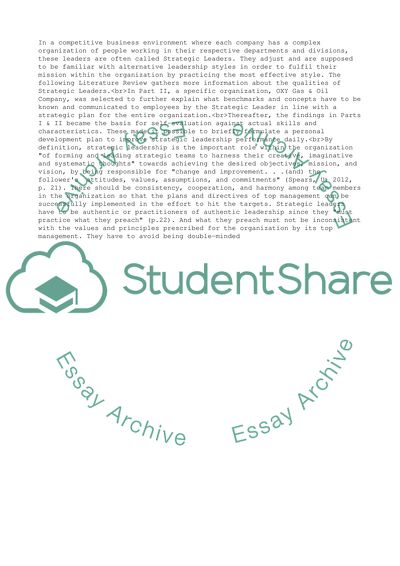
- Home
- Free Samples
- Premium Essays
- Editing Services
- Extra Tools
- Essay Writing Help
- About Us
- Studentshare
- Subjects
- Management
- The Strategic Leadership in Oxy Gas & Oil Company
The Strategic Leadership in Oxy Gas & Oil Company - Literature review Example

- Subject: Management
- Type: Literature review
- Level: College
- Pages: 24 (6000 words)
- Downloads: 0
- Author: vgrant
Extract of sample "The Strategic Leadership in Oxy Gas & Oil Company"
The paper "The Strategic Leadership in Oxy Gas & Oil Company" is an outstanding example of a management literature review. While it may be true that different people have different leadership styles depending greatly on their personalities, there are characteristics in a person to distinguish him from many other people who are called followers. In a changing world, particularly for those in the business organization, a good leader can be recognized by the accuracy in his way of comprehending the real situation in the light of various external and internal events.
This is followed by the flexible behaviour of adjusting to a leadership style required by the circumstances to take the initiative in guiding, motivating, and directing people towards an ideal yet achievable goal. In a competitive business environment where each company has a complex organization of people working in their respective departments and divisions, these leaders are often called Strategic Leaders. They adjust and are supposed to be familiar with alternative leadership styles in order to fulfil their mission within the organization by practicing the most effective style.
The following Literature Review gathers more information about the qualities of Strategic Leaders. In Part II, a specific organization, OXY Gas & Oil Company, was selected to further explain what benchmarks and concepts have to be known and communicated to employees by the Strategic Leader in line with a strategic plan for the entire organization.Thereafter, the findings in Parts I & II became the basis for self-evaluation against actual skills and characteristics. These made it possible to briefly formulate a personal development plan to improve strategic leadership performance daily.I.Literature ReviewBy definition, strategic leadership is the important role within the organization “of forming and leading strategic teams to harness their creative, imaginative and systematic thoughts” towards achieving the desired objectives, mission, and vision, by being responsible for “change and improvement. . .(and) the follower’s attitudes, values, assumptions, and commitments” (Spears, U. 2012, p. 21).
...Download file to see next pages Read MoreCHECK THESE SAMPLES OF The Strategic Leadership in Oxy Gas & Oil Company
Strategic Management - Tullow Oil Company
Operation management
Formation of Strategies in Oman Oil Company
Management Theory into Practice
Establishing a New Industrial Fabrication Yard
Strategic Leadership
Study of the Financial Structure and Role of Financial Institutions in Ensuring Faster Economic Growth
Leadership in Qatar Petroleum Company

- TERMS & CONDITIONS
- PRIVACY POLICY
- COOKIES POLICY